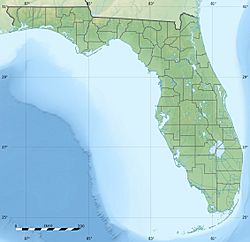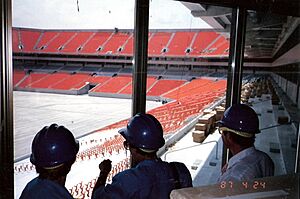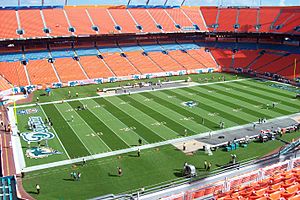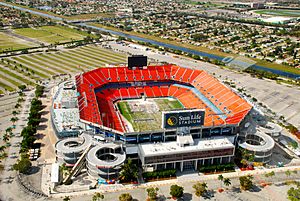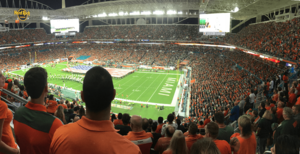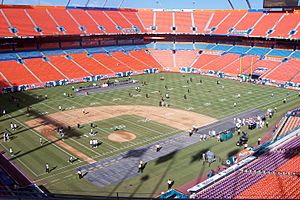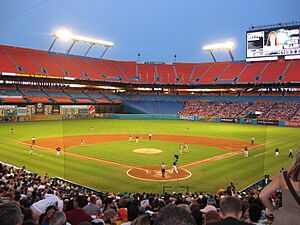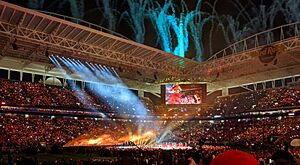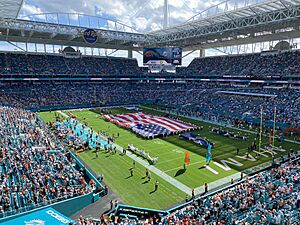Hard Rock Stadium facts for kids
 |
|

The stadium before Super Bowl LIV
|
|
| Former names |
List
|
|---|---|
| Address | 347 Don Shula Drive |
| Location | Miami Gardens, Florida, United States |
| Coordinates | 25°57′29″N 80°14′20″W / 25.95806°N 80.23889°W |
| Parking | 26,718 cars |
| Owner | Stephen M. Ross |
| Capacity | Football: 64,767 Tennis: 14,000 Original: 75,000 |
| Record attendance | Football: 80,120 (2013 BCS National Championship Game) Baseball: 67,498 (1997 World Series Game 6) |
| Surface | Tifway 419 Bermuda grass |
| Construction | |
| Broke ground | December 1, 1985 |
| Opened | August 16, 1987 |
| Construction cost | $115 million ($313 million in 2022 ) |
| Architect | HOK |
| Project manager | George A. Fuller Company |
| Structural engineer | Bliss & Nyitray Inc. |
| Services engineer | Blum Consulting Engineers |
| General contractor | Huber, Hunt & Nichols |
| Tenants | |
|
|
Hard Rock Stadium is a huge stadium in Miami Gardens, Florida. It's a place where many different events happen. It's the home field for the Miami Dolphins, a professional football team. It's also where the Miami Hurricanes college football team plays.
This stadium has hosted many exciting events. These include six Super Bowls, which are the championship games for the NFL. It also hosted two World Series baseball championships. Big college football games like the BCS National Championship Game and the Orange Bowl have been played here.
Beyond football and baseball, the stadium hosts the Miami Open tennis tournament. Since 2022, it has also been home to the Miami International Autodrome. This is a temporary race track for Formula One's Miami Grand Prix. The stadium has also hosted matches for the 2024 Copa América soccer tournament. It will host more soccer games for the 2025 FIFA Club World Cup and the 2026 FIFA World Cup.
The stadium first opened in 1987 as Joe Robbie Stadium. Over the years, it has had many different names. These include Pro Player Stadium, Dolphins Stadium, and Sun Life Stadium. In 2016, the stadium was named Hard Rock Stadium. This name will stay until 2034.
Contents
History of Hard Rock Stadium
Building the Stadium
For 21 years, the Miami Dolphins played at the Miami Orange Bowl. The team's founder, Joe Robbie, decided to build a new stadium. He wanted a stadium that could be used for many different sports. It was special because it was the first big stadium in the U.S. built with only private money.
Robbie thought a Major League Baseball (MLB) team would eventually come to South Florida. So, he had the stadium built with a wide field. This made it easy to change the field for baseball or soccer. However, this meant the first row of seats was quite far from the football field. This made it feel less close to the action for football fans.
When it opened in 1987, the stadium was in Miami-Dade County. Today, it is part of the city of Miami Gardens.
Miami Dolphins Home Games
The Miami Dolphins played their first game here on August 16, 1987. It was a preseason game against the Chicago Bears. The first regular season NFL game was on October 11, 1987. The Dolphins won 42–0 against the Kansas City Chiefs.
The Dolphins have played eight playoff games at the stadium. This includes the 1992 AFC Championship Game. They have won five of these playoff games. A famous game here was the "Miracle in Miami" in 2018. The Dolphins scored a winning touchdown on the very last play against the New England Patriots.
Miami Hurricanes Football Games
Since 2008, the stadium has been the home for the Miami Hurricanes college football team. This team has won five national championships. The university signed a 25-year contract to play here until 2033. Before this, the Hurricanes played at the Miami Orange Bowl for many years.
Florida Marlins Baseball Games
From 1993 to 2011, the stadium was also home to the Florida Marlins baseball team. The stadium was designed to easily host baseball games. In 1990, Wayne Huizenga helped bring a Major League Baseball team to South Florida. The Marlins started playing here in 1993. They even won two World Series titles in 1997 and 2003!
However, the stadium wasn't perfect for baseball. It was built mainly for football. The colors of the stadium matched the Dolphins. Sometimes, you could see football field marks during baseball games. The seats were also far from the baseball field. Many seats in the upper deck were too far to see the game well.
Also, South Florida summers are very hot and humid. The stadium didn't have a roof to protect fans from the heat or rain. This made it uncomfortable for baseball games. Because of these issues, the Marlins moved to their own baseball-only stadium in 2012.
Stadium Upgrades and Changes
After the Marlins left, the stadium got a big makeover. In 2015, a $350 million renovation project began. This included new video boards in each corner of the stadium. A large open-air canopy was added to cover the main seating areas. This canopy helps shield fans from rain and sun.
The renovation also reduced the seating capacity from 75,000 to 65,000 seats. New luxury seating areas were added. These included "pods" with comfortable furniture and TVs. The old orange seats were replaced with aqua-colored ones.
Tennis at Hard Rock Stadium
In 2017, the Miami Open tennis tournament announced it would move to Hard Rock Stadium. This move happened in 2019. To host the tournament, 29 new tennis courts were built in the stadium's parking lots. The main stadium itself becomes the center court for big matches. Temporary stands are built on the football field for this.
The move was popular with players and fans. They liked the extra space the new complex provided. In 2020, a gondola called SkyView opened. It gives great views of the stadium and the Miami skyline.
Stadium Seating and Parking
The stadium has 65,326 permanent seats for football and soccer. This includes regular seats, club seats, and executive suites. There are also special accessible seats for people with disabilities.
Around the stadium, there's a huge parking area. It can hold over 24,000 cars, along with buses, RVs, and limousines. There's even a helipad!
Exciting Events at Hard Rock Stadium
NFL Football Games
Hard Rock Stadium has hosted six Super Bowls. These are some of the biggest sports events in the United States. It also hosted the 2010 Pro Bowl.
In 2007, Super Bowl XLI was played here during heavy rain. This showed the need for a roof to protect fans. After renovations in 2016, a large canopy was added. It covers the seats but not the field. This helps keep fans comfortable.
The stadium's field runs east–west, which meant the north stands got very hot in the early season. To help fans, the Dolphins owner asked the NFL to schedule September home games later in the day. In 2021, the Dolphins opened a new training complex next to the stadium.
| Date | Super Bowl | Winning Team | Score | Losing Team | Attendance |
|---|---|---|---|---|---|
| January 22, 1989 | XXIII | San Francisco 49ers | 20–16 | Cincinnati Bengals | 75,597 |
| January 29, 1995 | XXIX | San Francisco 49ers | 49–26 | San Diego Chargers | 74,107 |
| January 31, 1999 | XXXIII | Denver Broncos | 34–19 | Atlanta Falcons | 74,803 |
| February 4, 2007 | XLI | Indianapolis Colts | 29–17 | Chicago Bears | 74,512 |
| February 7, 2010 | XLIV | New Orleans Saints | 31–17 | Indianapolis Colts | 74,059 |
| February 2, 2020 | LIV | Kansas City Chiefs | 31–20 | San Francisco 49ers | 62,417 |
College Football Games
The stadium has been home to the Miami Hurricanes since 2008. It also hosted the Florida Atlantic Owls for a short time.
Many important college bowl games have been played here. This includes the BCS National Championship Game in 2009 and 2013. The 2013 game set a new attendance record for the stadium with 80,120 fans! The stadium has also hosted the famous Orange Bowl game since 1996.
WrestleMania XXVIII
On April 1, 2012, the stadium hosted WrestleMania XXVIII. This is a huge professional wrestling event. Over 78,000 fans watched famous wrestlers like The Rock and John Cena. The event brought in a lot of money for Miami.
Baseball Championships
Hard Rock Stadium hosted many important baseball playoff games when the Marlins played there. This included two National League Division Series, two National League Championship Series, and two World Series (in 1997 and 2003).
For the World Series, the stadium opened up all its seats. Over 67,000 fans came to watch the Marlins win. Even though it wasn't a perfect baseball stadium, it saw some amazing moments.
Concerts and Music Festivals
Many famous musicians have performed at Hard Rock Stadium. Artists like Paul McCartney, U2, The Rolling Stones, Beyoncé, and Taylor Swift have held concerts here. These shows often draw tens of thousands of fans.
The stadium also hosts the large hip-hop music festival Rolling Loud. This festival brings in huge crowds to see top artists.
Soccer Matches

Hard Rock Stadium has hosted many exciting soccer matches. This is because South Florida has a large population of soccer fans. Teams from around the world, like FC Barcelona, Real Madrid, Brazil, and Colombia, have played here.
In 2013, a friendly match between Brazil and Honduras had 71,124 fans. This was the highest attendance for a soccer match at the stadium at that time. In 2017, a famous "El Clásico" match between Barcelona and Real Madrid was played here.
The stadium hosted several matches for the 2024 Copa América tournament, including the final game. It will also host games for the 2025 FIFA Club World Cup and the 2026 FIFA World Cup. For the World Cup, the stadium will be called "Miami Stadium."
Other Fun Events
The stadium has hosted many other events. These include Monster Jam monster truck shows, boxing matches, and even Australian rules football games. During the COVID-19 pandemic, it was used as an outdoor movie theater and a drive-in theater. It also became a COVID-19 testing site.
In 2021, Formula 1 announced a 10-year deal to host races around the stadium. This created the exciting Miami Grand Prix.
Stadium Names Over Time
The stadium has had many different names since it opened. It started as Joe Robbie Stadium in 1987. Joe Robbie, the Dolphins owner, didn't want it named after him, but people insisted!
Later, the naming rights were sold to different companies. It was called Pro Player Stadium, then Dolphins Stadium, and Dolphin Stadium. For a short time, it was even called Land Shark Stadium after a beer brand.
In 2010, it became Sun Life Stadium. When that deal ended in 2016, it was briefly called New Miami Stadium during renovations. Finally, in August 2016, it became Hard Rock Stadium. This name comes from the Hard Rock Cafe company.
| Name | Years |
|---|---|
| Joe Robbie Stadium | 1987–1996 |
| Pro Player Park | 1996 |
| Pro Player Stadium | 1996–2005 |
| Dolphins Stadium | 2005–2006 |
| Dolphin Stadium | 2006–2009 |
| Land Shark Stadium | 2009–2010 |
| Dolphin Stadium | 2010 |
| Sun Life Stadium | 2010–2016 |
| New Miami Stadium | 2016 |
| Hard Rock Stadium | 2016–present |
Images for kids
See also
 In Spanish: Hard Rock Stadium para niños
In Spanish: Hard Rock Stadium para niños



